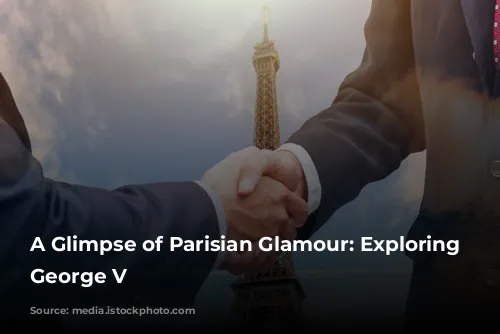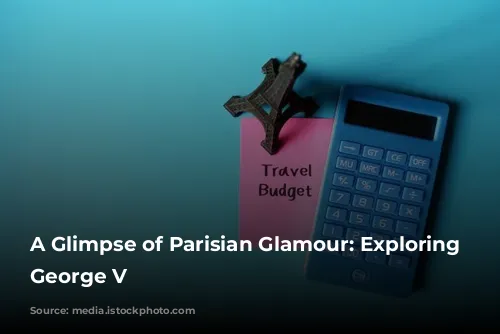Avenue George V, a prominent thoroughfare in the 8th arrondissement of Paris, holds a special place in the City of Lights. Nestled within the Champs Elysées district and the coveted “Golden Triangle”, it’s a haven for luxury and elegance. Renowned boutiques, grand palaces, lively restaurants, and pulsating nightclubs all grace its prestigious landscape. The Crazy Horse, a legendary cabaret, adds a touch of Parisian mystique to the avenue. While the Chinese and Spanish embassies once held court here, they have since moved elsewhere. Avenue George V, a majestic avenue, stretches for 730 meters and boasts a width of 40 meters.

A Royal Tribute: The Avenue’s Origins
Avenue George V was bestowed its name on July 14, 1918 as a tribute to King George V of the United Kingdom (1865-1936). The avenue served as a gesture of appreciation for the King’s unwavering leadership during the First World War. Before its royal renaming, this street was known as “Avenue de l’Alma”. A notable landmark, the Hippodrome des Champs Elysées, occupied the corner where Avenue George V intersects with Avenue du Président-Wilson between 1877 and 1893. This transformation of the neighborhood truly reflects Paris’ constant evolution.

A Monarch’s Reign: The Legacy of King George V
King George V, who reigned from May 6th, 1910, until his death in 1936, ascended the throne during a tumultuous period. Despite a personality not naturally suited to such a period of change, George V left an undeniable mark on history. A passionate philatelist, he played a pivotal role in establishing the Royal Philatelic Collection, which became the most comprehensive stamp collection in the United Kingdom and the Commonwealth.
King George V faced numerous challenges during his reign, including the First World War. He served as a steadfast friend and advisor to General Haig, who would later be promoted to Field Marshal. In 1917, amidst anti-German sentiment in the United Kingdom, he made the impactful decision to confer purely English titles on members of the royal family with Germanic surnames. This resulted in the English royal family’s name changing from Saxe-Coburg and Gotha to Windsor.
The aftermath of the First World War brought its own set of challenges. George V, a man of principle, accepted the limitations of his powers and, in 1924, appointed the first Labour Prime Minister, marking a significant shift in the political landscape. During his reign, the world witnessed the rise of powerful ideologies like socialism, communism, fascism, Irish republicanism, and Indian independence.

A Monarch’s Legacy: Navigating Political Challenges and Family Affairs
King George V’s reign was not without its political controversies. He openly objected to the anti-Catholic wording in the declaration of accession to the throne, which he was obligated to read at the opening of Parliament. Determined to uphold his principles, he refused to open Parliament until the controversial passages were removed. This led to the Accession Declaration Act of 1910, which shortened the declaration by removing the objectionable parts.
By 1922, Ireland was effectively divided into the Irish Free State in the south and Northern Ireland in the north. The rise of Adolf Hitler in 1933 deeply concerned George V. In 1934, he boldly conveyed his worries to the German ambassador, Leopold von Hoesch, warning that Germany was endangering world peace and that a war was inevitable within a decade. His concerns were further conveyed to his ambassador in Berlin, Eric Phipps.
The latter years of King George V’s reign were marked by strained relations with his eldest son, Edward, who caused disappointment with his refusal to marry and his numerous affairs with married women. However, King George V adored his second son, Albert, and his eldest granddaughter, Elizabeth, whom he affectionately called “Lilibet”. This is the Queen Elizabeth II we know today. In 1935, he expressed his anxieties about his sons, stating, “after my death, that boy [Edward] will be ruined in a year” and “I pray to God that my eldest son [Edward] may never have a wife or children, and that nothing may prevent Bertie and Lilibet from taking the throne.”

A Symbol of Loss: A Crown Falling in the Gutter
During the procession carrying King George V’s body into Westminster Hall, a portion of the Imperial Crown of India fell from the coffin and landed in the gutter as the procession turned into New Palace Yard. The future king, Edward VIII, witnessing this incident, wondered if it was an ill omen for his reign. Ironically, he abdicated in December 1936 due to his controversial love affairs. His brother, Albert of York, was crowned as George VI, and eventually, his daughter, Elizabeth II, ascended the throne.

A Stroll Through Parisian Elegance: Landmarks on Avenue George V
Avenue George V boasts a wealth of iconic buildings and landmarks that contribute to its allure. A walk along this magnificent avenue reveals a tapestry of Parisian elegance and history:
- Givenchy boutique (3rd floor, Hôtel de Caraman): This prestigious boutique exudes sophistication and style.
- Hôtel de Ganay (9): Built in 1896-1898, this grand hotel was once a social hub, attracting the crème de la crème of Parisian society, including sports aristocracy. Today, it serves as the headquarters of the Permanent Assembly of the Chambers of Agriculture. Its interior decoration is a testament to its rich past.
- Balenciaga – Women’s Boutique (10): A haven for fashion enthusiasts, Balenciaga’s presence on Avenue George V is a testament to its enduring influence on the world of fashion.
- The Crazy Horse (12): This world-famous cabaret adds a touch of Parisian allure and intrigue to the avenue.
- Hôtel de Wagram (15): After a series of transformations, this building now houses the Chancellery of the Spanish Embassy.
- Holy Trinity American Episcopal Church (American Cathedral of Paris) (23): Built in 1881-1884 in the neo-Gothic style, this beautiful church stands as a testament to the presence of American culture in Paris.
- Four Seasons Hotel George V (31): This five-star hotel, established in 1928, has become a symbol of Parisian luxury and hospitality.
- Prince de Galles hotel (33): This five-star hotel, inaugurated in 1928, has witnessed the presence of numerous historical figures, including Winston Churchill, Marlene Dietrich, Charles Laughton, Dalida, and Elvis Presley.
- Fouquet’s Barrière (46): This five-star hotel gained notoriety when Nicolas Sarkozy celebrated his victory in the 2007 presidential elections at its restaurant, creating controversy among uninvited journalists.
Beyond Avenue George V: A Journey into Parisian History
Continuing your journey from Avenue George V, a short walk leads to the Avenue des Champs Elysées. The iconic Arc de Triomphe, located just 100 meters away, stands as a symbol of Parisian grandeur and history. It beckons visitors to delve deeper into the heart of Paris, where history and modern life intertwine to create an unforgettable experience.








